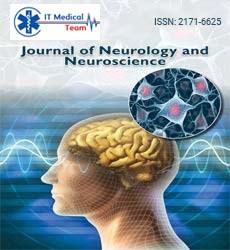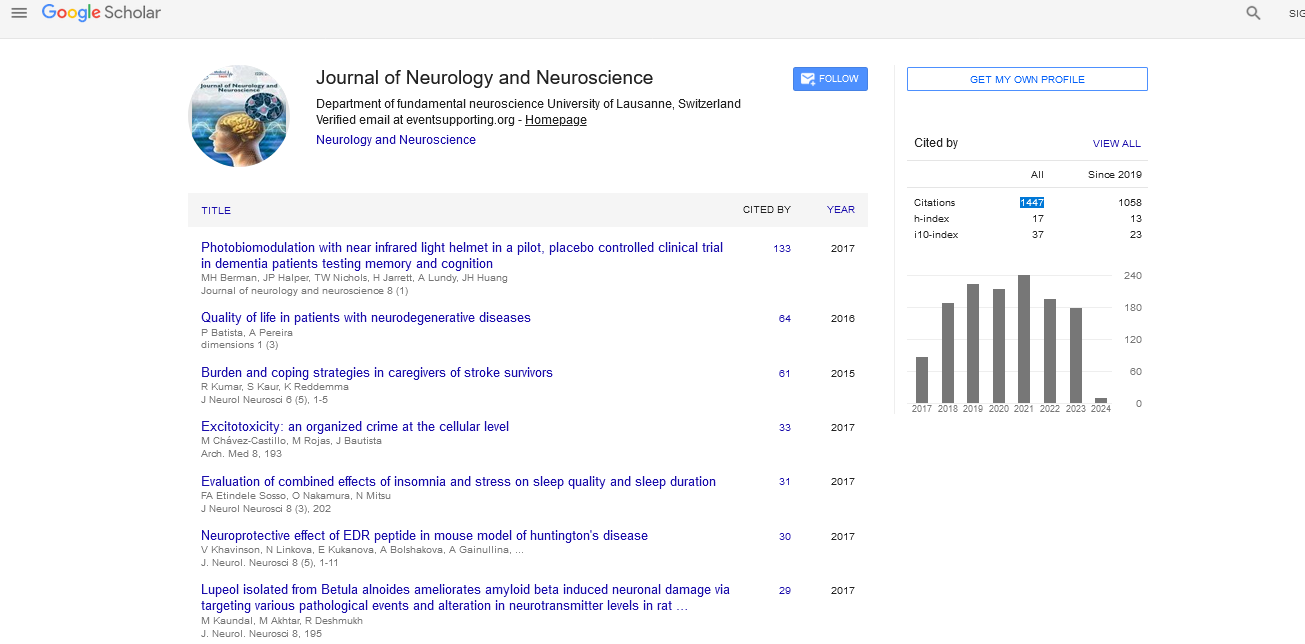Commentary - (2024) Volume 15, Issue 5
The regenerative brain mechanisms and implications of neurogenesis
Giorgia Marino*
Department of Neurosurgery, ASST Ovest Milano Legnano Hospital, 20025 Legnano, Milan, Italy
*Correspondence:
Giorgia Marino, Department of Neurosurgery, ASST Ovest Milano Legnano Hospital, 20025 Legnano, Milan,
Italy,
Email:
Received: 03-Oct-2024, Manuscript No. ipjnn-24-15393;
Editor assigned: 05-Oct-2024, Pre QC No. P-15393;
Reviewed: 18-Oct-2024, QC No. Q-15393;
Revised: 24-Oct-2024, Manuscript No. R-15393;
Published:
31-Oct-2024
Introduction
Neurogenesis, the process through which new neurons
are formed in the brain, has emerged as a fascinating field
of study, challenging the long-held belief that the adult
brain is incapable of generating new cells. Traditionally,
it was thought that neurogenesis only occurred during
development and ceased shortly after birth. However,
groundbreaking research over the past few decades has
demonstrated that neurogenesis can persist into adulthood,
particularly in specific regions of the brain, such as the
hippocampus, which is associated with memory and
learning. This article explores the mechanisms underlying
neurogenesis, its implications for brain health, and its
potential applications in treating neurological disorders [1].
Neurogenesis involves a series of complex processes,
including the proliferation of Neural Stem Cells (NSCs),
their differentiation into mature neurons, and the
integration of these neurons into existing neural circuits.
Neural stem cells are undifferentiated cells with the ability
to self-renew and differentiate into various types of brain
cells, including neurons, astrocytes, and oligodendrocytes.
In adult mammals, these stem cells are primarily located
in the subgranular zone of the dentate gyrus, part of the
hippocampus. Under certain conditions, such as physical
exercise, environmental enrichment, and learning, these
NSCs can be stimulated to divide and differentiate.
Under favorable conditions, NSCs enter the cell cycle,
proliferating to form a population of progenitor cells [2].
These progenitor cells can then differentiate into
neuroblasts, which will ultimately mature into functional
neurons. Newly formed neurons extend their axons and
dendrites, forming synapses and integrating into existing
neural networks. The process of neurogenesis is regulated
by various intrinsic and extrinsic factors, including growth
factors, neurotransmitters, and environmental stimuli.
Brain-Derived Neurotrophic Factor (BDNF) is one of the
most studied neurotrophic factors, playing a critical role
in promoting the survival, growth, and differentiation of
neurons. Neurogenesis is influenced by a multitude of
factors, both positive and negative. Understanding these
factors is crucial for harnessing neurogenesis in therapeutic
contexts. Regular aerobic exercise has been shown to
significantly enhance neurogenesis. Exercise increases levels
of BDNF and promotes blood flow to the brain, which
provides essential nutrients and oxygen [3].
Description
Exposure to a stimulating environment with opportunities for exploration and social interaction
can enhance neurogenesis. This includes exposure to
novel experiences and challenges that promote cognitive
engagement. Engaging in tasks that require learning can
also promote neurogenesis. The acquisition of new skills
and knowledge stimulates the production of neurotrophic
factors and creates a demand for new neurons. Certain
dietary components, such as omega-3 fatty acids found in
fish, and polyphenols present in fruits and vegetables, have
been linked to enhanced neurogenesis. Prolonged exposure
to stress hormones, particularly cortisol, can inhibit
neurogenesis. Stress reduces the proliferation of NSCs
and can lead to the atrophy of the hippocampus. While
neurogenesis occurs throughout life, its efficiency declines
with age. Aging is associated with reduced neurogenic
activity, which may contribute to cognitive decline and
increased susceptibility to neurodegenerative diseases [4].
Alcohol and drugs can negatively affect neurogenesis.
Chronic alcohol consumption has been shown to reduce
the proliferation of NSCs and impair the integration
of new neurons. Chronic inflammation, often seen in
various neurological disorders, can inhibit neurogenesis.
Pro-inflammatory cytokines can impair the survival and
function of newly formed neurons. The ability of the brain
to generate new neurons has significant implications for
brain health, cognitive function, and the treatment of
neurological disorders. Neurogenesis in the hippocampus
is closely linked to learning and memory. Studies have
shown that increased neurogenesis can enhance cognitive
function, improve memory retention, and facilitate
the ability to adapt to new information. Conversely, a
decline in neurogenesis has been associated with cognitive
impairments and memory deficits, particularly in aging
populations [5].
Emerging evidence suggests that neurogenesis plays a
role in mood regulation and mental health. For instance,
individuals suffering from depression often exhibit reduced
neurogenic activity. Antidepressant treatments, particularly
those that increase levels of BDNF, have been shown to
promote neurogenesis, highlighting a potential mechanism
through which these treatments exert their effects.
Moreover, neurogenesis may be implicated in the brain's
ability to recover from traumatic experiences. Enhancing
neurogenesis could provide a therapeutic avenue for
individuals suffering from Post-Traumatic Stress Disorder
(PTSD) and other trauma-related conditions.
The potential for neurogenesis to contribute to recovery
from neurodegenerative diseases, such as Alzheimer’s
and Parkinson’s, is an area of intense research. While
neurogenesis alone may not be sufficient to replace the vast
loss of neurons in these diseases, enhancing neurogenic
pathways could help to improve cognitive function and
delay the progression of symptoms. Strategies that promote
neurogenesis, including physical activity, cognitive
training, and dietary modifications, are being investigated
as adjunctive therapies to conventional treatments for
neurodegenerative diseases. Given the central role of
neurogenesis in brain health, researchers are exploring
various therapeutic applications aimed at enhancing
this process. Several pharmacological agents are being
investigated for their potential to promote neurogenesis.
For example, certain antidepressants, such as Selective
Serotonin Reuptake Inhibitors (SSRIs), have been shown
to increase the proliferation of NSCs.
Lifestyle modifications can play a crucial role in
promoting neurogenesis. Encouraging physical activity,
cognitive engagement, and a balanced diet rich in nutrients
that support brain health may provide non-invasive
strategies for enhancing neurogenic activity. Developing
community-based exercise programs tailored for older
adults can encourage regular physical activity and improve
cognitive function through enhanced neurogenesis.
Programs that promote cognitive engagement through
puzzles, learning new skills, or social interactions can
stimulate neurogenesis and improve mental health. Dietary
recommendations that emphasize the consumption
of omega-3 fatty acids, antioxidants, and other
neuroprotective nutrients could help maintain neurogenic
activity throughout life. Innovative therapeutic approaches,
such as stem cell therapy, are being explored as potential
treatments for neurological disorders. By transplanting
NSCs or inducing endogenous NSCs to proliferate and
differentiate, researchers aim to repair damaged neural
circuits and restore function in the brain. While still in
experimental stages, these approaches hold promise for
conditions characterized by significant neuronal loss, such
as stroke, traumatic brain injury, and neurodegenerative
diseases.
Conclusion
The discovery of neurogenesis in the adult brain has
profound implications for our understanding of brain health
and disease. By elucidating the mechanisms that regulate
neurogenesis, we open the door to potential therapeutic
strategies that can enhance cognitive function, improve
mental health, and mitigate the effects of neurodegenerative
diseases. As research continues to uncover the intricate
relationship between neurogenesis and various factors
influencing brain health, it is imperative to integrate this
knowledge into public health initiatives, clinical practice,
and lifestyle interventions. The regenerative potential
of the brain underscores the importance of nurturing
our neurological health throughout our lives, paving the
way for a future where the brain’s capacity for renewal
is harnessed to improve quality of life and cognitive
resilience. Understanding and promoting neurogenesis not
only enriches our grasp of the brain’s capabilities but also
illuminates new pathways for therapeutic intervention in
an era where mental health and cognitive vitality are of
paramount importance.
Acknowledgement
None.
Conflict of Interest
None.
References
- Allyn MM, Luo RH, Hellwarth EB, et al. Considerations for polymers used in ocular drug delivery. Front Med 2022; 8:787644.
Google Scholar, Crossref, Indexed at
- Xing Y, Zhu L, Zhang K, et al. Nanodelivery of triamcinolone acetonide with plga-chitosan nanoparticles for the treatment of ocular inflammation. Artif cells nanomed biotechnol. 2021; 49(1):308-316.
Google Scholar, Crossref, Indexed at
- Wu KY, Tan K, Akbar D, et al. A new era in ocular therapeutics: Advanced drug delivery systems for uveitis and neuro-ophthalmologic conditions. Pharmaceutics. 2023; 15(7):1952.
Google Scholar, Crossref, Indexed at
- Tettamanti M, Buccino G, Saccuman MC, et al. Listening to action-related sentences activates fronto-parietal motor circuits. J Cogn Neurosci. 2005; 17(2):273-281.
Google Scholar, Crossref, Indexed at
- Pulvermüller F, Hauk O, Nikulin VV, Ilmoniemi RJ. Functional links between motor and language systems. Eur J Neurosci. 2005; 21(3):793-797.
Google Scholar, Crossref, Indexed at





